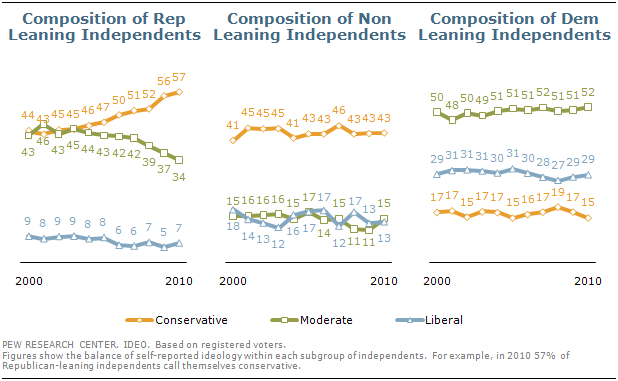Partisan affiliation has shifted in small but important ways several times over the past two decades, with several politically consequential changes occurring the in past few years. After holding a 10-percentage point 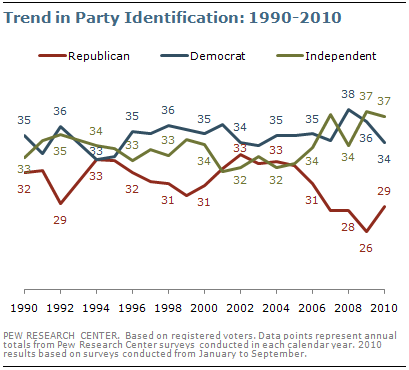 advantage in party identification among registered voters in 2008 and 2009, the Democratic Party now has only a five-point lead in 2010. Fewer voters identify as Democrats and more identify as Republicans.
advantage in party identification among registered voters in 2008 and 2009, the Democratic Party now has only a five-point lead in 2010. Fewer voters identify as Democrats and more identify as Republicans.
This year, 34% of registered voters identify as Democrats and 29% as Republicans. In 2009, on average, 36% identified as Democrats, compared with 26% who said they were Republicans, little diff
erent from 2008 when Democrats had a 38% to 28% advantage over Republicans. The Democratic Party’s 10-point lead in 2008 and 2009 grew from a much more modest 35% to 31% gap in 2006 and a narrow 34% to 33% edge in 2002.
Amidst these ups and down in affiliation with the two major parties, the number of independents and non-partisans now stands at 37%, one of the highest levels in the past 20 years of Pew Research Center polling. The proportion of independents has fluctuated in recent years, but the current number is sharply higher than it was several years ago (32% in 2002).
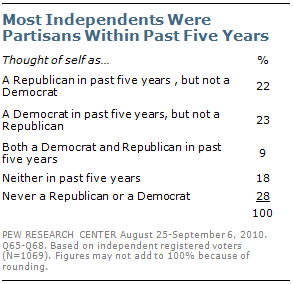 The recent changes in partisan identification serve as a reminder that affiliation with a party is an attitude, one which can and does change. Previous research has shown that few people switch immediately from Republican to Democratic identification or vice versa. Most of the movement is from independents who assume a party label or from partisans who no longer identify with their former party.
The recent changes in partisan identification serve as a reminder that affiliation with a party is an attitude, one which can and does change. Previous research has shown that few people switch immediately from Republican to Democratic identification or vice versa. Most of the movement is from independents who assume a party label or from partisans who no longer identify with their former party.
In fact, most of the survey’s independent and non-partisan voters report changing their party affiliation – 72% say they have thought of themselves as a Republican, a Democrat or both at some point in their life and 54% considered themselves a partisan in the past five years. About one-in-five independent voters (22%) say they considered themselves a Republican (but not a Democrat) during this period, while 23% of independents considered themselves a Democrat (but not a Republican).
More Independents Lean Republican
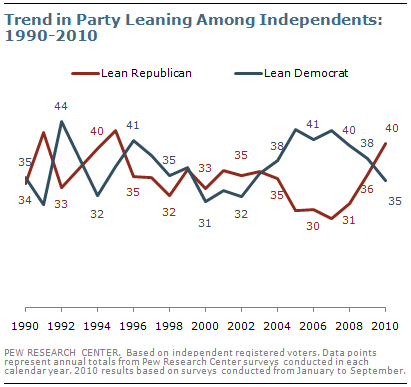 In 2010, 40% of independents and other non-partisan voters say they lean more to the Republican Party, 35% say they lean more to the Democratic Party; and 25% of independents decline to lean. These numbers reflect considerable change over the past four years.
In 2010, 40% of independents and other non-partisan voters say they lean more to the Republican Party, 35% say they lean more to the Democratic Party; and 25% of independents decline to lean. These numbers reflect considerable change over the past four years.
Just a year ago, 36% of independents leaned to the GOP and 38% leaned Democratic, while 26% did not state a preference for either party. Consequently, over the past year party leaning among independent voters has shifted from a two-point Democratic lead to a five-point Republican advantage. And the shift is even more dramatic from 2006 when Democrats enjoyed an 11-point lead in independent leaning.
In the current survey, 84% of Republican leaners plan to vote for the GOP candidate in their district this November (compared with 94% among Republicans) and 82% of Democratic leaners plan to vote for the Democratic Party’s candidate (compared with 91% among Democrats). By comparison, the majority (58%) of those who do not lean to either party are undecided, while 21% support the Republican candidate and 21% back the Democratic candidate for Congress.
The growth in the percentage of independents who lean Republican has been accompanied by an uptick in the proportion who describe their views as conservative. Currently, 36% of independents say they are conservative, up from 29% in 2006. Over the same period, the proportion of independent who are moderates declined from 46% to 43%, while the number describing themselves as liberal edged downward two points (from 18% to 16%). (For more on ideological shifts among the electorate, see pg.30).
Why Independents Are Independent
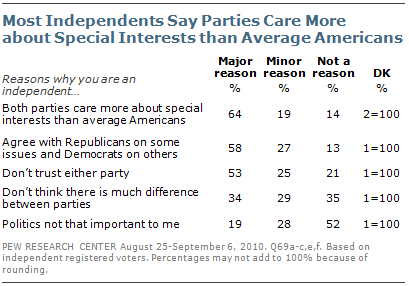 In response to a series of questions about why they are independent, majorities of non-partisan voters cite three different factors as major reasons for rejecting a party label. Nearly two-thirds (64%) say that both parties caring more about special interests than about average Americans is a major reason for their independent status. A smaller 53% majority says a major reason for being independent is that they don’t trust either political party.
In response to a series of questions about why they are independent, majorities of non-partisan voters cite three different factors as major reasons for rejecting a party label. Nearly two-thirds (64%) say that both parties caring more about special interests than about average Americans is a major reason for their independent status. A smaller 53% majority says a major reason for being independent is that they don’t trust either political party.
Nearly six-in-ten (58%) say a major reason they are non-partisan is that they agree with the Republicans on some issues and the Democrats on other issues. For example, pluralities of independents say the GOP comes closer to their views on some issues and the Democrats come closer on others. More independents say the Republican Party comes closer to their views than the Democratic Party on economic issues (43% Republican vs. 34% Democrat) and foreign policy and national security (44% Republican vs. 30% Democrat). But the Democrats have an edge over Republicans on social issues among non-partisans (39% Democrat, 33% Republican).
Less commonly cited were two other reasons for being an independent, including a belief that there is little difference between the parties. About a third (34%) says not thinking there is much difference between the parties is a major reason for their independent status. Only 19% of non-partisans say that a major reason they are independent is because politics is not that important to them.
Ex-Partisans Support Their Former Parties
 Independents who say they previously identified as Republicans or Democrats have positive views of their former parties. Fully 79% of independent voters who thought of themselves as Republicans in the past five years lean to the GOP and the same percentage (79%) favors the Republican candidate in their district.
Independents who say they previously identified as Republicans or Democrats have positive views of their former parties. Fully 79% of independent voters who thought of themselves as Republicans in the past five years lean to the GOP and the same percentage (79%) favors the Republican candidate in their district.
Similarly, former Democrats overwhelmingly lean Democratic (76%) and plan to vote for a Democrat in November (73%). And just as voters who affiliate with the Republican Party are more engaged in the election, the same is true among independents who used to belong to the GOP: 79% say they will definitely vote and 70% say they are giving a lot of thought to the election. That compares with just 59% and 36%, respectively among former Democrats.
The midterm preferences of independents who have not recently considered themselves a Democrat or a Republican are much more divided – 39% favor the GOP candidate and 36% back the Democratic candidate while 26% are undecided. There is a similar pattern in their partisan leaning; 38% lean to the Republican Party, 34% to the Democratic Party and 27% refuse to lean to either party. But the plurality of this group voted for Obama over McCain in 2008 (41% Obama, 27% McCain). Among the independents who have been consistently nonpartisan over the past five years, 43% have given a lot of thought to the election and 60% say they definitely will vote, about on par with former Democrats.
When it comes to political ideology, former Republicans are far more conservative than other independents. About two-thirds (66%) describe their political views as conservative, 25% as moderate and only 7% as liberal. By contrast only 19% of former Democrats say their political views are conservative, 46% are moderate, and 33% are liberal. A third of independents who have not been a Republican or a Democrat in the past five years describe their views as conservative, 40% as moderate, and 21% as liberal.
For the most part, former Republicans, former Democrats and voters who have not recently considered themselves partisans agree on the reasons why they are independents. For instance, large majorities in all three groups say both parties care more about special interests than about average Americans. But 61% of former Republicans say they do not trust either party, compared with 46% of former Democrats. About half (53%) of those who have not recently affiliated with a party say they do not trust either party.
Where Republicans, Former Republicans Differ
 Former Republicans share many opinions with Republican partisans – particularly about Barack Obama and the size of government. But there are also key differences of opinion about George W. Bush, the Iraq war and social issues.
Former Republicans share many opinions with Republican partisans – particularly about Barack Obama and the size of government. But there are also key differences of opinion about George W. Bush, the Iraq war and social issues.
Notably, Tea Party support is as high among former Republica
ns as it is among Republicans – 60% of former Republicans and 56% of Republicans agree with the Tea Party movement. Similarly, 81% of former Republicans say they would rather have a smaller government with fewer services, as do 82% of Republicans.
Nearly as many former Republicans (81%) as Republicans (85%) disapprove of Obama’s job performance. Disapproval of health care reform is nearly as high among former Republicans (81%) as it is among Republicans (87%).
But former Republicans express a less favorable view of George W. Bush – 61% have a favorable opinion of him compared with 76% of Republicans. And one of the major policies of the Bush administration, the Iraq war, garners much less support among former Republicans than among Republicans – 54% of former Republicans say the U.S. made the right decision in using military force in Iraq while 70% of Republicans say it was the right decision.
There are also differences over social issues. About six-in-ten (59%) former Republicans oppose allowing gays and lesbians to marry legally while 30% favor this. But Republicans oppose same-sex marriage by a 74% to 20% margin. And while at least three-fourths of former Republicans say the GOP comes closer to their views on economic issues (79%) and foreign policy and national security (76%), only 60% say the same about social issues such as same-sex marriage and abortion.
Where Democrats, Former Democrats Differ
Former Democrats express less positive views about Obama and his policies than do Democrats. On ratings of Obama’s overall job performance, 65% of former Democrats approve, compared with 83% of Democrats. And while Democrats support the health care reform legislation by more than four-to-one (76% approve, 18% disapprove), the margin is smaller among former Democrats (59% approve, 30% disapprove).
There also are sharp differences in views about government. Only 22% of former Democrats trust the government in Washington to do what is right just about always or most of the time, compared with 41% of Democrats. Democrats prefer bigger government with more services over a smaller one by nearly two-to-one (61% bigger, 31% smaller). Opinion about the size of government is much more divided among former Democrats – 46% prefer a bigger government while 44% would rather have a smaller government.
However, former Democrats and their partisan counterparts have more similar views about business and social issues. About seven-in ten former Democrats (71%) and Democrats (69%) think that business corporations make too much profit. And a nearly identical percentage of Democrats (58%) and former Democrats (59%) favor allowing gays and lesbians to marry legally. Similarly, 57% of former Democrats think our country needs to continue making changes to give blacks equal rights with whites, as do 63% of Democrats.
Ideological Shifts among Independents, Partisans
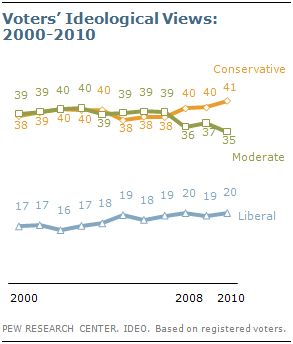 For most of the last decade the political ideology of American voters has been very stable. From 2000 to 2007, roughly four-in-ten voters described themselves as moderate and an equal share as conservative. About two-in-ten thought of themselves as liberal. In the last three years, however, the share identifying as conservative increased and the percentage identifying as moderate declined.
For most of the last decade the political ideology of American voters has been very stable. From 2000 to 2007, roughly four-in-ten voters described themselves as moderate and an equal share as conservative. About two-in-ten thought of themselves as liberal. In the last three years, however, the share identifying as conservative increased and the percentage identifying as moderate declined.
Among voters interviewed in 2010, 41% describe themselves as politically conservative. While conservative ideology is up 3 points from 2007 – the year Democrats assumed control of Congress – the percent who call themselves moderate is down four points (from 39% in 2007 to 35% in 2010). One in five (20%) say they are liberal, about the same percentage as in the past few years.
Some of the growth in conservative ideology is among Republican voters, but not all can be attributed to change among Republicans. Independents, specifically those who lean Republican, have become more conservative in recent years.
Since 2006, the year of the last midterm election, the percentage of Republican voters who call themselves conservative increased 4 points, from 66% to 70%. This is not a new trend within the Republican Party. The share of Republicans who call themselves conservative has grown since 2002, when 63% of Republicans called themselves conservative.
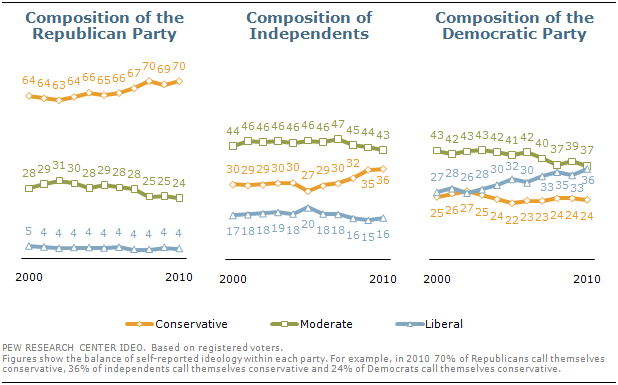
What has changed since the last midterm election is a growing percentage of independents who describe themselves as conservative. From 2006 to 2010, the share of independents who think of themselves as conservative increased seven points from 29% to 36%. Some of this increase may be attributable to the decline in Republican Party affiliation observed from 2006 to 2009. About two-in-ten (22%) of those who have shed their party affiliation in the last five years say they once thought of themselves as a Republican and fully two-thirds (66%) of this group call themselves conservative.
To be sure, not all of the growth in conservative ideology among independents is attributable to lapsed Republican identity. Republican Party affiliation increased three percentage points from 2009 to 2010 (26% to 29%), while independent identity remained stable, yet the percentage of independents calling themselves conservative edged slightly upward from 35% in 2009 to 36% in 2010.
Among Republican-leaning independents and non-partisans, conservative ideology both predominates and has steadily increased. Republican leaning independents are far more conservative today than just a few years ago. Currently, 57% of Republican leaning independents call themselves conservative and just 34% are moderate. In 2003, Republican leaning independents were just as likely to be moderate as conservative (45%). There is no comparable pattern among independents who lean Democratic or independents who do not lean toward a party. Today, 43% of non-leaning independents are conservative, just two points higher than in 2000. And only 15% of Democratic-leaning independents are conservative now, down two points from 2000.
